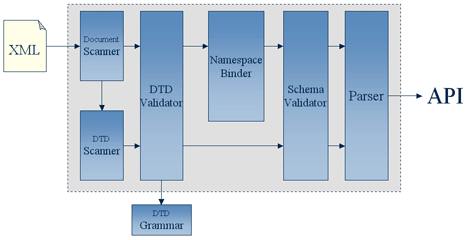The XNI parser pipeline is any combination of components that
are either capable of producing XNI events, consuming XNI events,
or both. All pipelines consist of a source, zero or more filters,
and a target. The source is typically the XML scanner; common
filters are DTD and XML Schema validators, a namespace binder,
etc; and the target is the parser that consumes the XNI events
and produces a common programming interface such as DOM or SAX.
The following diagram illustrates the basic pipeline configuration.

However, this is a simplified view of the pipeline configuration.
The Xerces Native Interface actually defines two different pipelines
with three interfaces: one for document information and two for DTD
information.
The Xerces2 parser, the reference implementation of XNI,
contains more components than the basic pipeline configuration
diagram shows. The following diagram shows the Xerces2 pipeline
configuration. The arrow going from left to right on the top of the
image represents the flow of document information and the arrows on
the bottom of the image represent the DTD information flowing through
the parser pipeline.

As the diagram shows, the "Document Scanner" is the source for
document information and the "DTD Scanner" is the source for DTD
information. Both document and DTD information generated by the
scanners flow into the "DTD Validator" where structure and content
is validated according to the DTD grammar, if present. From here,
the validated document information with possible augmentations such
as default attribute values and attribute value normalization flows
to the "Namespace Binder" which applies the namespace information to
elements and attributes. The newly namespace-bound document
document information then flows to the "Schema Validator" for
validation based on the XML Schema, if present. Finally, the
document and DTD information flow to the "Parser" which generates
a programming interface such as DOM or SAX.
XNI defines the document information using a number of core
interfaces. (These interfaces are described in more detail in the
Core API documentation.) But XNI
also defines a set of interfaces to build parser configurations
that assemble the pipelines in order to parse documents. The next
section gives a general overview of the this parser configuration
provided by XNI.

